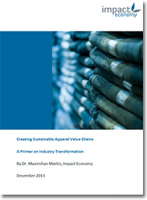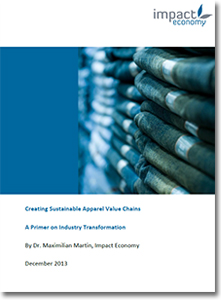Creating Sustainable Apparel Value Chains - A Primer on Industry Transformation
Our findings indicate that creating a win-win of raising productivity and competitiveness, as well as social and environmental performance is possible. But an ambitious, systemic approach is needed to achieve industry transformation.
The global textile and garment industry is at a crossroads.
It is a three trillion dollar industry that encompasses the manufacturing and selling of textiles and garments, and has long been considered a source of economic progress around the world, historically serving as a catalyst for national development and industrialization.
The flipside of this growth and the accelerating production of fashion has been a broadening and deepening track record of poor working conditions and heavy pollution.
The collapse of the Rana Plaza factory in April 2013 in Dhaka, Bangladesh jolted to life widespread and increasingly prolonged scrutiny of the industry. This incident has brought longstanding questions to the forefront over how to bridge the gap between economic viability and social and environmental performance.
This Primer attempts to sort through the minefield of perspectives, expectations, and challenges that have only grown more complicated in recent months, and provide an evidence-based assessment of the prospect of sustainable value chains in the textile and garment industry.
The report is intended for stakeholders in the apparel industry to use as they deliberate how they can achieve the leap forward needed. The findings are based on extensive desk research and informed by evidence gathered from reaching out to over 730 industry stakeholders through an online survey, conducting more than 25 expert interviews and site visits, reviewing over 200 reports on the overall industry or some relevant dimension of it, and leveraging our general insights into innovation, impact, investment and market building.
The textile and garment industry is global, but its main production clusters are in Asia, thus the Primer also includes five country spotlights: China and Bangladesh, the industry’s largest sourcing locations; Myanmar and Thailand, production locations in the midst of transition; and Japan, the world’s third-largest apparel market.
Our findings indicate that creating a win-win of raising productivity and competitiveness, as well as social and environmental performance is possible. But an ambitious, systemic approach is needed to achieve industry transformation.
What’s Related

Favorites





